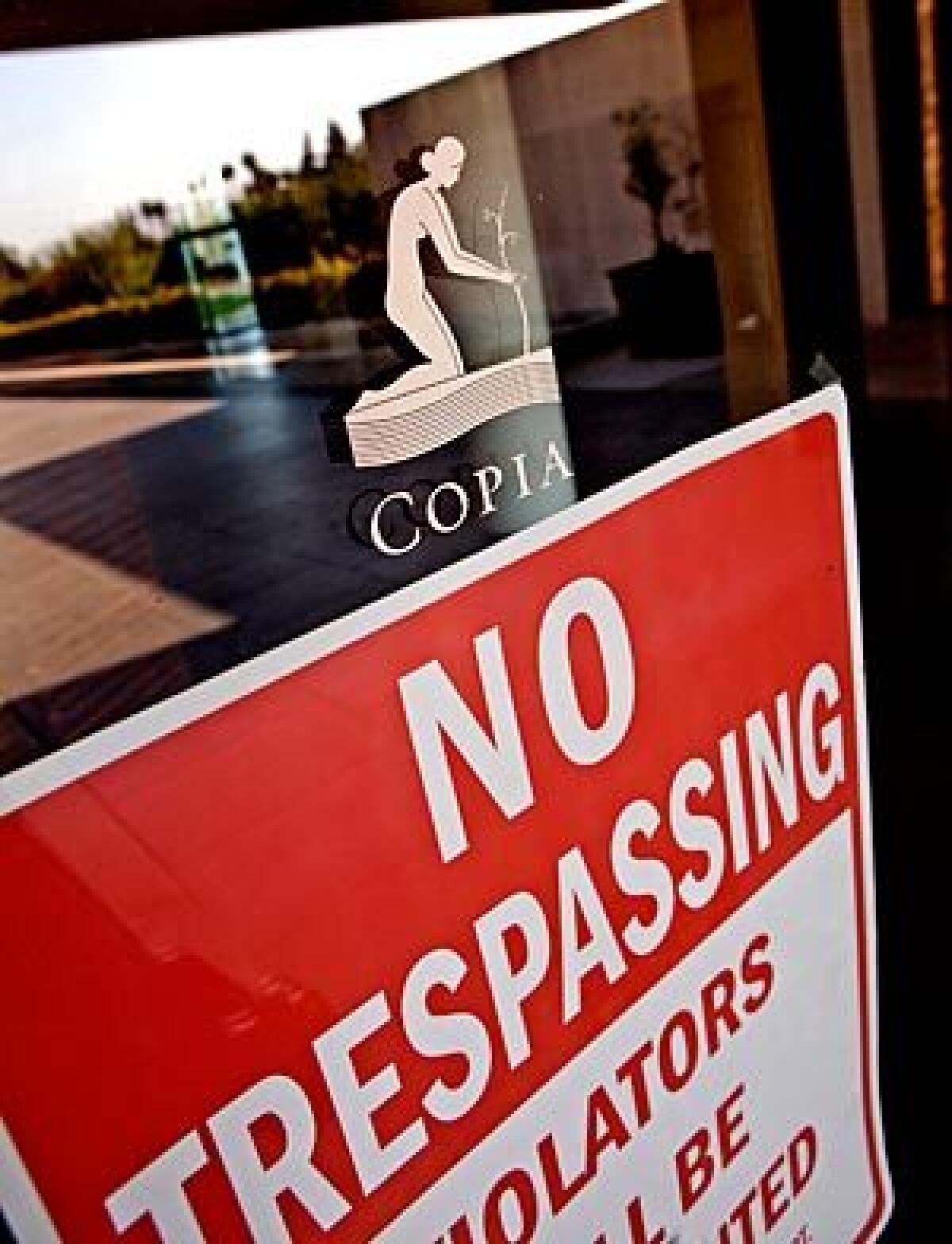Writing a new chapter in Napa’s rebirth

- Share via
What’s a town gotta do to gain some cachet? The city of Napa has new homes, new hotels, new shops and new restaurants. The once-neglected river that runs through town has been reclaimed, historic buildings have been restored, and developers have poured hundreds of millions of dollars into downtown.
Even though it’s not nestled amid vineyards and the main street into downtown is lined with shopping centers and car dealerships, a year ago the valley’s namesake city (long considered the poor stepsister to Yountville and St. Helena) was being touted as a destination in its own right. The working-class community at the southern end of the region was catching up to its fancier “up valley” counterparts, each new development promising a rebirth of downtown.
Now, its decade-long renaissance in the making -- which seems perpetually just shy of reaching critical mass -- is again hanging in the balance.
A cornerstone of the revitalization is the downtown-adjacent Oxbow District, which features an upscale market complex to rival San Francisco’s Ferry Building Marketplace and two luxury hotel projects. But in the center of that is a real estate crater -- the bankrupt Copia: The American Center for Wine, Food and the Arts, the late vintner Robert Mondavi’s 80,000-square-foot stone and concrete monolith, now empty and plastered with “no trespassing” signs.
A city in flux
As summer’s high tourist season gets underway along Highway 29 -- the main artery to Napa Valley’s wine country -- there is a palpable sense of a town with high hopes, still struggling toward a vision. Not only is Copia closed, but as the economy waivers, brand-new riverfront condos sit empty and hotels and restaurants expect to see fewer visitors.
“Copia played a major role in the growth of downtown and was instrumental in creating a destination,” says Steve Carlin, founder and chief executive of the Oxbow Public Market, which opened next to Copia in December 2007. “It drew a lot of attention to Napa.
“I located the market in the Oxbow District not specifically because of Copia but because I thought the whole area was going to be the Soho of downtown Napa.”
There certainly is promise. There are efforts to revive Copia in some form. And the city has been promised $99 million in stimulus money to help complete its extensive flood control project, of which the Oxbow District is a significant part.
Already the area includes the Oxbow market, the upscale Westin Verasa hotel, the Oxbow Commons (which will be an open public space after it is excavated to accommodate the flood project’s bypass channel), and the Oxbow Preserve, a 13-acre nature and wildlife refuge. Directly across the Napa River, ground is expected to be broken this year for a more-than-$200-million Ritz-Carlton.
“We studied the valley and believe in this location,” says Brad Weiser of Continental Cos. of Miami, the hotel’s developer. “Obviously we’re disappointed in what has happened, but I’ve been in touch with several of the people who have expressed an interest in Copia. Hopefully if they can get through the legal process, it’s going to be the asset it can be for the city of Napa.”
Downtown, a 1.35-acre retail/residential project called the Riverfront has opened along the river, changing the downtown skyline with ground-floor restaurant and retail space sitting below 50 condominiums.
Copia’s key role
Right in the middle of it all stands Copia. A community group called the Coalition to Preserve Copia and others interested in occupying the building, such as the Culinary Institute of America, may yet reinvent it.
Few downplay the importance of the vision that was Copia. Propped against a wall in Mayor Jill Techel’s office is a poster-size illustrated map of the Oxbow District, a loop of land created by a U-shaped bend in the Napa River and on which Copia sits. When Mondavi bought land here for Copia more than 10 years ago, it was a dusty 12-acre lot next to a tire store on what was considered “the wrong side of the tracks.” (Mondavi died in May 2008.)
“Years ago, I didn’t know I had an Oxbow District until the staff said, ‘Let’s talk about the Oxbow,’ ” Techel says. “It was, ‘Close your eyes and imagine that you’ll be at this hotel and across from it will be a park and you’ll be able to go by the Oxbow Market and stop in at [wine] tasting rooms.’ None of that was there before Copia,” which opened at the end of 2001.
Even though most agree it’s a key property in Napa’s revitalization, Copia is still a community hot-button issue that brings up tensions between locals and tourists, as well as locals and vintners from other parts of the valley (who made up much of its board).
What was Mondavi’s dream has become a sore point for some locals. What was conceived as a monument to food and wine culture came across to some as winemakers’ monument to themselves. Local visitors were put off by high admission prices (which later were reduced) and early exhibits such as a vending machine filled with defecating figurines (or caganers). Locals, some of whom have resisted other changes that have come with gentrification (more stoplights, for instance), complained that there was nothing for them to do or see, though later the museum and culinary center offered movie nights and a farmers market.
A May editorial in the Napa Valley Register facetiously suggested that it be turned into the International Taco Truck Hall of Fame and Museum.
Copia collapsed into bankruptcy in December under the weight of its $78-million bond debt. Mondavi had donated the land and more than $20 million toward its $55-million construction, but Copia never attracted enough visitors to cover its operating costs, which were as much as $14 million a year.
Moving ahead
Bankruptcy negotiations between Copia and bond insurer ACA Financial Guaranty Corp. have been lengthy and sometimes contentious. But last month an agreement was reached between Copia and ACA that clears the way for ACA to take possession of the building and sell it.
If the Coalition to Preserve Copia, a group of Napa businesspeople, has its way, the building will reopen in the fall. Headed by local developers Harry Price and John Salmon, the coalition is among several interested potential buyers, including the Culinary Institute of America and other developers. Salmon says he was encouraged to take action by hotel owners who have seen vacancies rise since Copia closed and conferences were canceled. It’s a community effort “to develop a reuse plan that honors Mondavi’s original intentions and serves Napa’s wine and food world in a sustainable way, so it’s not back in bankruptcy three years from now.”
But even if all of Copia’s problems are solved, that probably won’t mean an end to Napa’s challenges. Main Street is going through its own ups and downs. Besides the restored Napa Valley Opera House and Hatt Mill Building, there are more than 20 wine tasting rooms and about 40 restaurants, including Ubuntu -- the vegetarian restaurant/yoga studio that opened in 2007 and put downtown Napa on the map in food circles.
Copia was a catalyst for much of this, says Craig Smith, executive director of the Napa Downtown Assn. “But Copia’s not the domino” that causes everything else to fall.
Still, nobody wants to see it remain empty. “The sooner it reopens, the better,” Techel says. And after it reopens with expected conference space, hotels -- such as the newly opened Avia Hotel downtown as well as the Westin in the Oxbow -- stand only to gain.
But Copia isn’t the only space to fill. Empty storefronts (some vacant more than a year) still dot Main Street as well as the nearby Napa Town Center mall, though developers say they have renewed efforts to lease stores. And much of the highly touted Riverfront, Napa’s first mixed-use development, has yet to be leased.
Also slow to reach fruition is Napa’s unique flood control project, which aims to create a “living river” with river bank terracing and a parkland bypass channel instead of a concrete channel like the L.A. River. But the project has been delayed due to cuts in federal funding (it is also partly funded by a local sales tax). Approved in 1998, it was what encouraged developers to build in flood-prone Napa.
Originally slated to be completed in 2006, it is about half-finished, according to city officials. But it received a big boost this spring when the U.S. Army Corps of Engineers announced that it would extend a whopping $99 million to the project, now slated to be finished in 2011 or 2012.
It’s the kind of thing that has those still banking on Napa optimistic, despite recurring setbacks.
“We’re getting in at a great time,” says chef-restaurateur Ken Frank, who moved his restaurant, La Toque, from Rutherford to the Westin Verasa in the Oxbow District. “The dynamic is shifting south, and a few years from now Napa will be sharp.”
More to Read
Eat your way across L.A.
Get our weekly Tasting Notes newsletter for reviews, news and more.
You may occasionally receive promotional content from the Los Angeles Times.











